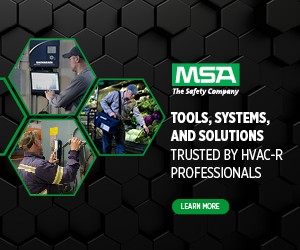Designing for DX Technology: Four Steps
The reduction in the amount of ammonia charge needed to refrigerate a facility reduces the risks associated with an ammonia release, both to people and to products. A smaller system ammonia charge also offers the potential for reduced regulatory requirements in large facilities and opens the industry to potential new applications for ammonia in smaller commercial systems.
The use of DX ammonia can reduce the evaporator charge by as much as 30 to 50 times compared with bottom-feed flooded or pumped designs. In other words, when the evaporator is operated with DX ammonia, it contains only 1/30th to 1/50th the amount of ammonia used in traditional pump ammonia evaporators, significantly minimizing safety risks. In addition to reducing the ammonia charge, DX technology also reduces power consumption compared with pump recirculated systems by eliminating the need for the liquid overfeed pumps, and by minimizing suction line pressure losses – a result of operating suction lines dry instead of wet. Finally, because of smaller vessel and line sizes and the elimination of the recirculator package found in a pumped ammonia system, the comparative initial cost of a DX ammonia system is lower.
The reduced risk associated with ammonia leaks combined with excellent energy efficiency makes DX ammonia attractive for smaller commercial systems, such as food service distribution centers, which have been traditionally cooled by HFC refrigerants.
“The application of direct expansion with ammonia in low temperatures is something we haven’t been able to do until now. This technology allows the application of DX ammonia to freezers, blast freezing and other low-temperature applications,” said Bruce Nelson, president of DX system manufacturer Colmac Coil Manufacturing and author of the DX Ammonia Piping Handbook.
The magnitude of the reduction in ammonia charge made possible by DX ammonia also reduces regulatory requirements of the Environmental Protection Agency, Occupational Safety and Health Administration and the Department of Homeland Security, and potentially cuts insurance risk and premiums. That is because DX technology allows the building of a large cold storage facility, one with up to 1,500 tons of refrigerating capacity, using a total on-site ammonia charge under the 10,000-pound regulatory threshold.
“Once you get over 10,000 pounds all three federal agencies take an intense interest in what you’re doing,” Nelson said. “With the new DX technology now available, you can operate a large facility with only six to seven pounds of ammonia per ton of refrigeration. When you use secondary fluids to cool the higher temperature rooms, you can drive that down to less than three pounds of ammonia per ton of refrigeration.”
Before designing and installing a system using DX technology, Nelson said the following four steps should be followed:
- The evaporator must be carefully selected to include the proper type of tubing which includes an internal enhancement designed specifically for DX ammonia. The high ratio of vapor to liquid specific volume of ammonia at low temperatures, combined with its very high latent heat of vaporization, causes an unavoidable separation of vapor and liquid phases inside evaporator tubes. This separation of phases causes the liquid ammonia to run along the bottom of the tubes, leaving the top of the tubes completely “dry.” The result is extremely poor evaporator performance and lower-than-expected suction. The new DX technology solves this problem with an enhancement technique that mitigates that separation to improve performance even at low temperatures.
- The system must be designed to capture and remove water from the ammonia. Even small amounts of water in the ammonia will significantly penalize DX ammonia evaporator performance. Water must be effectively removed during operation, particularly in freezing systems that operate at suction pressures below one atmosphere (in a vacuum). The negative effect of small amounts of water on evaporator performance has not been fully recognized in the past, but must be addressed during the design of the DX ammonia system. With the Low Temperature DX Ammonia system, it is possible to successfully apply DX ammonia at suction temperatures down to minus-50 degrees F.
- There must be proper piping for handling defrost condensate. In a pumped ammonia system, defrost condensate is normally returned to one of the recirculator vessels where it is simply pumped back out, or “recirculated,” to the evaporators. In a DX system the defrost condensate is not recirculated and so must be carefully considered in the system design. The best approach is always to return defrost condensate to the high-pressure suction accumulator or intercooler, where it can be used to do useful work such as subcooling highpressure liquid and intercooling booster discharge gas.
- Proper control and distribution of the expanded ammonia to the evaporator coil is critical for good performance. Using an electronic expansion valve with its matched superheat controller is key to stable control of the evaporator. A suitable refrigerant distributor is also important to ensure uniform delivery of the expanded ammonia to all of the evaporator circuits while also allowing unrestricted flow of hot gas during defrosting.
In summary, DX ammonia technology offers three major benefits. First is the inherently safer design resulting from the significant reduction in ammonia charge. Second, DX ammonia reduces power consumption and operating costs making it attractive not only for industrial facilities but also for commercial applications previously dominated by HFCs. Finally, the cost of installing DX ammonia is lower than traditional pumped ammonia designs.
“First and foremost, DX ammonia technology reduces the amount of ammonia needed to refrigerate a facility, so it is inherently a safer technology,” Nelson said. “You’re also offering the end user the very attractive benefits of lower first cost and lower operating costs.”















